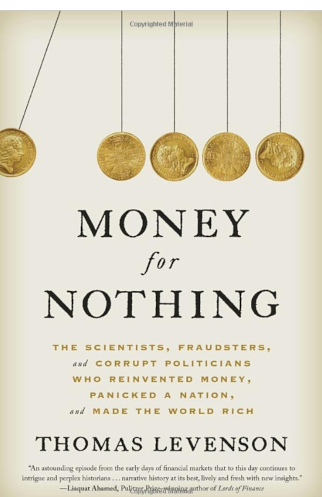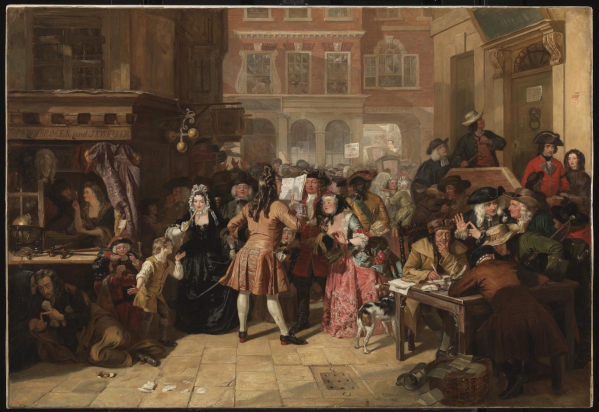
Reflections on Vancouver, British Columbia and other topics, related or not
Capital crimes
Money for Nothing re-examines the South Sea bubble,
warning of even worse financial chaos to come
Greg Klein | October 13, 2020
The South Sea Bubble, a Scene in ’Change Alley in 1720,
an 1847 painting by Edward Matthew Ward.
(Tate Gallery/Creative Commons)
It’s a lesson in human nature as much as financial engineering that the Scientific Revolution could spawn such irrationality. As Thomas Levenson recounts in Money for Nothing, the mania that burst in 1720 owed its development to new ideas in mathematics and concepts of finance. The exuberance that followed showed symptoms of insanity but also of naivete, the author says, as people responded to innovation in unprecedented circumstances. We are the ones, he maintains, who lack excuses for allowing even worse catastrophes to follow.
Still, South Sea was one wild ride. A trading company that did almost no trading, it ranks with its Dutch tulip bubble predecessor and Mississippi bubble contemporary as one of history’s most outrageous pre-2008 speculative frenzies.
The South Sea Company based its pretence of value on trading privileges in Spanish New World ports and a revenue stream from taking on Britain’s entire public debt. Not big on integrity, the company’s trade included slaves and the massive debt-for-equity swap required a “ruthless campaign of bribery” to pass the houses of Commons and Lords.
At the outset, holders of various long- and short-term government paper—including bonds, notes, annuities and lotteries—exchanged them in £100 allotments for shares at face value. But the share prices took on an exuberance of their own.
As the act passed on April 2, 1720, the shares with their face value of £100 in debt sold for £275. Two days later they hit £350.
On April 14 directors disregarded the face value altogether by setting the first money subscription price (sold for cash, not government paper) at £300. Buyers jammed the company’s office. At the same time a short distance away, hustlers in London’s already notorious Exchange Alley were flogging the shares at £317. The next money subscription went for £400.
… the key issue wasn’t that the powerful were corruptible. It was that they were persuadable, willing in those sweet days of spring to believe in the revolutionary possibilities of financial alchemy and the prospect of wealth without tears.
—Thomas Levenson
Intrinsic value? Potential enterprise? No need for such trifles.
In late April the company began lending punters the money to buy, using the purchase as collateral, “creating a kind of circular financial engine” to further inflate the price. Installment plans and dividends paid in shares further primed the pump.
By the end of May the stock hit £595. “Nothing had actually happened to justify such a move,” Levenson writes. Shares closed June 17 on £755. That month directors issued another money subscription, this time at £1,000, £250 more than brokers were asking and for scrip still showing a face value of £100. The £5-million offer sold out within hours.
Who on earth was paying that? Just about everyone with money, including “at least half of both houses of Parliament…. Aristocratic ladies were still buying too—among them, the Prince of Wales’ daughters.” Not immune was Isaac Newton, the mathematician/physicist paragon of the Scientific Revolution. Yet “some core players grasped the danger—hence the eager land purchases by Company directors in May and June. Even at inflated prices, those deals still turned paper fortunes into useful dirt.”
Summer saw some moderately corrective dips as passions wavered. Betraying desperation, directors offered a seemingly huge 50% dividend—but that was on the £100 face value, working out to a measly 5% on the £1,000 subscription price, about what goldsmiths paid on deposits. “It was time to cut and run.”
That shareholders did. By October 1 the price fell below £300 permanently, eventually sinking beneath the shares’ face value.
“No particular genius was required to diagnose what had happened: a stock buoyed by the belief in its infinite possibilities could not be saved by Company promises once that faith was lost.”

As individuals got wiped out, contagion took down some private banks. The Whigs’ Bank of England was pressured into a bailout attempt. Some of the biggest profiteers were penalized to partially compensate some of the losers. The company actually did some trade up to 1739. But thanks to incompetent management, not even the shipment of at least 30,000 slaves could contribute to an overall profit.
The scheme did reform Britain’s debt financing, Levenson argues. A legacy of almost relentless war, the amount had been spread out over a tangled mess of long- and short-term obligations. New loans brought increasingly high interest from increasingly dubious lenders. Once the South Sea scheme piled all those loans into one package, the government demonstrated its ability to pay the interest, even if the principal remained foreboding. Lenders responded with greater willingness and lower rates.
The ability to borrow, Levenson points out, proved crucial to Britain’s military prowess, in turn crucial to colonial expansion and global might.
England, later Britain, and France had waged war against each other throughout most of the period between 1689 and 1815. France was generally at least twice as rich and three times as populous. Yet the island persevered and ultimately triumphed thanks to “Britain’s secret weapon—the key to the Treasury’s ability to borrow, at reasonable rates, even in an emergency. The South Sea Company, once the engine of national disaster, had become instead a machine processing the credit that allowed British leaders to spend as needed whenever needed to protect what they saw as the national interest.”
Global expansion followed as “what came out of that debacle—the unprecedented financial agility of the British state—outstripped even the most extravagant hopes of the Bubble year.”
It all resulted from the new ideas led by people like Newton, who “taught his contemporaries to think, not just about money, but about anything that could be observed, measured and counted.”
Their work led to “the emergence of forms of credit subject to calculation and mathematical analysis [that] created new forms of money.” On the one hand, it seemed rational, empirical and objective. On the other hand, it incited mobs to pay 10 times the face value of paper.
If Isaac Newton, his time’s avatar of reason, couldn’t control his passions long enough to think his choices through, how many others would?
—Thomas Levenson
And Newton was among those drawn in. Why?
Among possible explanations, Levenson says that humans are social animals influenced by each other’s behaviour. Additionally, some punters were swayed by false info propagated by insiders.
But there was “one sure fact of the Bubble: it was the first of its kind. There was no historical memory to help anyone in Europe see how it would end. The mathematical tools of financial analysis were being worked out on the spot—and no one yet knew if such calculations truly described reality.”
It’s people of today’s much more interconnected world who should be guarding against collapse, the author emphasizes. The Lehman Brothers debacle, “a lineal descendant of the financial maneuvers of the South Sea Bubble,” might just be a prelude to an even greater disaster than 2008.
“The Bubble’s history is not simply past,” Levenson warns.
